#micropyle
Text
Several stages in the development of the endosperm coenocyte of Arabidopsis are shown in Figure 21.24. (...) Cellularization of the coenocyte endosperm in Arabidopsis begins in the micropylar endosperm region and progresses to the chalazal region (see Figure 21.24, parts E-G).
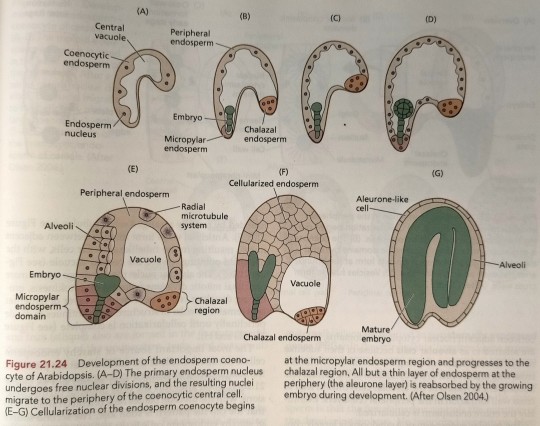
"Plant Physiology and Development" int'l 6e - Taiz, L., Zeiger, E., Møller, I.M., Murphy, A.
#book quotes#plant physiology and development#nonfiction#textbook#endosperm#coenocyte#arabidopsis#plant cells#cell differentiation#chalaza#alveoli#aleurone#micropyle
0 notes
Text
When the pollen tube senses chemical attractants secreted by the synergids, the tube grows through the micropyle, penetrates the embryo sac, and enters one of the synergid cells.
"Plant Physiology and Development" int'l 6e - Taiz, L., Zeiger, E., Møller, I.M., Murphy, A.
#book quote#plant physiology and development#nonfiction#textbook#pollen tube#chemicals#attractants#micropyle#embryo sac#synergids#plant cells#fertilization
0 notes
Text
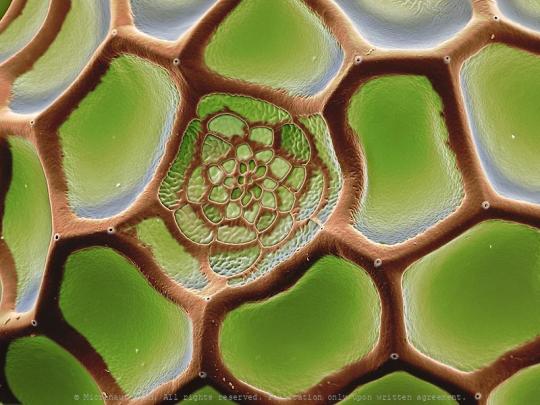

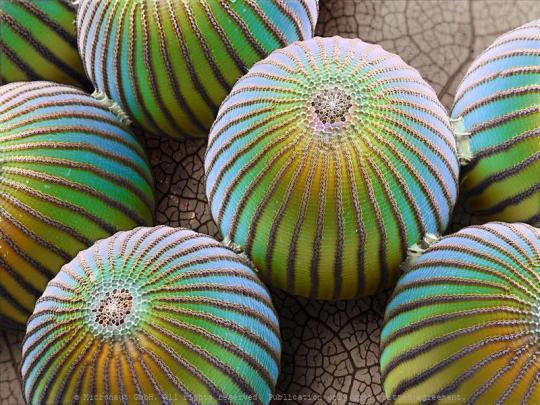
Butterfly eggs photographed by Martin Oeggerli. All rights reserved, shared with permission. See more of his butterfly egg photos here!
#so amazing!#insect eggs#Martin Oeggerli#that structure on top is called the micropyle#photography#microscopic images#owl butterfly#Caligo memnon#red lacewing butterfly#Cethosia biblis#insects#bugblr#butterflies
2K notes
·
View notes
Text
The micropyle of a plant ovary is basically the plants coochie lips…
4 notes
·
View notes
Text
In plants
In plants, a new plant can be formed from every organ like root, leaf, flower or fruit. Whereas in humans, a new human can be born from just one organ, the uterus. Are reproductive organs like the uterus present in every part of a plant?
As a plant's reproductive part, a flower contains a stamen (male flower part) or pistil (female flower part), or both, plus accessory parts such as sepals, petals, and nectar glands (Figure 19). The stamen is the male reproductive organ.
Ovary (botany)
Wikipedia
https://en.wikipedia.org › wiki › Ovary_(botany)
In the flowering plants, an ovary is a part of the female reproductive organ of the flower or gynoecium. Specifically, it is the part of the pistil which holds the ovule(s) and is located above or below or at the point of connection with the base of the petals and sepals. The pistil may be made up of one carpel or of several fused carpels (e.g. dicarpel or tricarpel), and therefore the ovary can contain part of one carpel or parts of several fused carpels. Above the ovary is the style and the stigma, which is where the pollen lands and germinates to grow down through the style to the ovary, and, for each individual pollen grain, to fertilize one individual ovule. Some wind pollinated flowers have much reduced and modified ovaries.
Parts of the ovary
Locules are chambers within the ovary of the flower and fruits. The locules contain the ovules (seeds), and may or may not be filled with fruit flesh. Depending on the number of locules in the ovary, fruits can be classified as uni-locular (unilocular), bi-locular, tri-locular or multi-locular. Some plants have septa between the carpels; the number of locules present in a gynoecium may be equal to or less than the number of carpels, depending on whether septa are present.
The ovules are attached to parts of the interior ovary walls called the placentae. Placental areas occur in various positions, corresponding to various parts of the carpels that make up the ovary. See Ovule#Location within the plant. An obturator is present in the ovary of some plants, near the micropyle of each ovule. It is an outgrowth of the placenta, important in nourishing and guiding pollen tubes to the micropyle.[17]
The ovary of some types of fruit is dehiscent; the ovary wall splits into sections called valves. There is no standard correspondence between the valves and the position of the septa; the valves may separate by splitting the septa (septicidal dehiscence), or by spitting between them (loculicidal dehiscence), or the ovary may open in other ways, as through pores or because a cap falls off.
Translate Hindi
पौधों में जड़ पत्ते फूल या फल हर एक अंग में से एक नए पौधें बन सकते है
जबकि हम मनुष्य में एक ही अंग यूटेरस में ही सिर्फ एक नए मनुष्य की जन्म हो सकते है
क्या यूटेरस जैसे जन्मदायी अंग पौधों की हर एक अंग अंश में होते है
पौधे के प्रजनन अंग के रूप में, एक फूल में पुंकेसर (नर फूल वाला भाग) या स्त्रीकेसर (मादा फूल वाला भाग), या दोनों होते हैं, साथ ही बाह्यदल, पंखुड़ियाँ और अमृत ग्रंथियाँ जैसे सहायक भाग भी होते हैं (चित्र 19)। पुंकेसर नर प्रजनन अंग है।
अंडाशय (वनस्पति विज्ञान)
विकिपीडिया
https://en.wikipedia.org › wiki › अंडाशय_(वनस्पति विज्ञान)
फूलों वाले पौधों में, अंडाशय फूल या जायांग के मादा प्रजनन अंग का एक हिस्सा होता है। विशेष रूप से, यह स्त्रीकेसर का वह हिस्सा होता है जो बीजांड (अंडाणुओं) को धारण करता है और पंखुड़ियों और बाह्यदलों के आधार के साथ जुड़ने के बिंदु के ऊपर या नीचे या उस पर स्थित होता है। स्त्रीकेसर एक कार्पेल या कई जुड़े हुए कार्पेल (जैसे कि द्विकार्पेल या त्रिकार्पेल) से बना हो सकता है, और इसलिए अंडाशय में एक कार्पेल का हिस्सा या कई जुड़े हुए कार्पेल के हिस्से हो सकते हैं। अंडाशय के ऊपर वर्तिका और वर्तिकाग्र होता है, जहां पराग उतरता है और वर्तिका से नीचे अंडाशय तक बढ़ने के लिए अंकुरित होता है, और प्रत्येक पराग कण के लिए, एक व्यक्तिगत बीजांड को निषेचित करता है। कुछ पवन परागित फूलों में बहुत कम और संशोधित अंडाशय होते हैं।
अंडाशय के भाग
स्थान फूल और फलों के अंडाशय के भीतर कक्ष होते हैं। स्थानों में बीजांड (बीज) होते हैं, और वे फलों के गूदे से भरे हो भी सकते हैं और नहीं भी। अंडाशय में स्थानों की संख्या के आधार पर, फलों को एक-स्थानिक (यूनीलोकुलर), द्वि-स्थानिक, त्रि-स्थानिक या बहु-स्थानिक के रूप में वर्गीकृत किया जा सकता है। कुछ पौधों में कार्पेल के बीच सेप्टा होते हैं; एक गाइनोकियम में मौजूद स्थानों की संख्या कार्पेल की संख्या के बराबर या उससे कम हो सकती है, यह इस बात पर निर्भर करता है कि सेप्टा मौजूद हैं या नहीं।
अंडाशय आंतरिक अंडाशय की दीवारों के कुछ हिस्सों से जुड़े होते हैं जिन्हें प्लेसेंटा कहा जाता है। प्लेसेंटल क्षेत्र विभिन्न स्थितियों में होते हैं, जो अंडाशय को बनाने वाले कार्पेल के विभिन्न हिस्सों के अनुरूप होते हैं। देखें बीजांड#प���धे के भीतर स्थान। कुछ पौधों के अंडाशय में प्रत्येक बीजांड के माइक्रोपाइल के पास एक ओबट्यूरेटर मौजूद होता है। यह प्लेसेंटा का एक प्रकोप है, जो पराग नलिकाओं को माइक्रोपाइल तक पोषण देने और मार्गदर्शन करने में महत्वपूर्ण है।[17]
कुछ प्रकार के फलों का अंडाशय विखंडित होता है; अंडाशय की दीवार वाल्व नामक खंडों में विभाजित हो जाती है। वाल्व और सेप्टा की स्थिति के बीच कोई मानक पत्राचार नहीं है; वाल्व सेप्टा को विभाजित करके (सेप्टीसाइडल डिहिसेंस) या उनके बीच थूकने से (लोकुलिसाइडल डिहिसेंस) अलग हो सकते हैं,
0 notes
Text
In the 1500s, scientists and naturalists were captivated by the study of plant structures, particularly the reproductive organs. It was during this time that the concept of orthotropism in plants emerged, with gophers serving as a prime example of this phenomenon.
But what exactly is orthotropism and why were gophers used as a model for it?
Orthotropism refers to the upright position of the ovule in plants, with the micropyle (a small opening through which the pollen can enter) located at the apex. This positioning is crucial for pollination, as it allows for efficient fertilization and seed development. While many plants exhibit this characteristic, gophers were of particular interest to scientists due to their unique role in plant reproduction.
Gophers, also known as pocket gophers, are burrowing rodents found in North and Central America. They are known for their extensive tunneling and burrowing activities, which have a significant impact on their surrounding ecosystems. However, it is their role in plant reproduction that made them stand out to scientists in the 1500s.
During this time period, it was believed that gophers played a critical role in the dispersion of plant seeds. As these rodents dug their tunnels, they would come across plant roots and seeds, which would then be carried along with them as they moved around. When eventually deposited in a new location, these seeds had a better chance of germination and survival. This process of seed distribution was likened to the fertilization process in plants, with gophers acting as pollinators.
Further studies showed that gophers also had a direct impact on a plant's reproductive success by creating holes in the ground that served as ideal locations for seed germination. The moist and protected environment of these holes provided a safe haven for seeds to develop and grow. Additionally, the gopher’s preference for dense vegetation also helped in seed dispersal and germination, as the plants would be in close proximity to one another, allowing for successful pollination and reproduction.
These observations led scientists to conclude that gophers were integral to the process of orthotropism in plants. Their burrowing activities and role in seed dispersal and germination were seen as crucial factors in maintaining the upright position of the ovule and aiding in successful pollination and reproduction.
In conclusion, the study of gophers in the 1500s shed light on the importance of orthotropism in plants and the role that these animals play in it. While our understanding of this phenomenon has since evolved, gophers continue to be a fascinating subject for scientific research and a reminder of the intricate connections between different species in ecosystems.
0 notes
Link
1 note
·
View note
Text
MAR. 21 '23

BUSINESS: started just a little of insurance revision but didn't get too far or anywhere in general..no we still do not have our mocks corrected or returned <3
AG. SCIENCE: 5wks till project due oooo okay well ignoring that we did farm layout planning which technically counts as an experiment but well yknow
economy of labor = making things ez for yourselfff put related things close to eachother ie summer dairy parlor & grazing platform, winter dairy parlor & winter housing, wide access for milk lorry 2 avoid reversing into yard, calf sheds near paddocks incase weather gets cold... store silage & feed close together like silage pit & concentrate storage... separate machinery vs. animal access routes
health & safety = separate fenced play area in line of sight of house; waterproof outdoor electrical sockets; fence water off; clear visibility = no crowding of shit; sliding doors cuz swinging doors are dangerous in high winds; signs; designated parking area for machinery
sustainability: hedgerows, field margins of wildflowers, fence off waterlogged grassland to turn into wet grassland meadow habitat...use 1 single tank to collect all soiled water... 16-22wk slurry storage... buffer zones = areas maintained in permanent vegetation adjacent to rivers and streams that help maintain water quality, prevent fertilizer & chemical runoff
BIOLOGY: everyone give a big round of applause for more plant sex
MALE GAMETE FORMATION:
4 pollen sacks in the anther, 1 diploid microspore mother cell in pollen sacks
diploid microspore mother cell divides via meiosis to form a tetrad (cluster of 4 haploid cells)
tetrad breaks into 4 individual haploid cells (microspores);
haploid cell divides by mitosis to create diploid pollen grain
pollen grain matures and forms an exine (rough thick outer layer) and intine (thin inner layer) around it, 1 nucleus = tube nucleus & 1 nucleus = generative nucleus
gen nucleus divides by mitosis later on into two sperm cells
FEMALE GAMETE FORMATION: polar nuclei + egg cell + embryo sac = female gamete
diploid megaspore mother cell divides by meiosis into 4 haploid cells; 3 of these die
remaining haploid cell divides by mitosis 3 times to create 8 haploid nuclei within an embryo sac; 5 of these die
2 remaining nuclei become polar nuclei, 1 remaining nucleus becomes egg cell
FERTILIZATION:
mature pollen grain lands on stigma
mature pollen grain absorbs water
tube nucleus controls the growth of a pollen tube through the stigma, down the style and thru the ovary to the micropyle (chemotropism!), degenerates upon meeting micropyle
generative nucleus moves through pollen tube
generative nucleus divides by mitosis into two sperm cells
sperm cells move past micropyle into embryo sac
1 sperm cell fuses with 2 polar nuclei = triploid endosperm (food source for seed), 1 sperm cell fuses with egg cell = diploid zygote

1 note
·
View note
Text
✨ الاعجاز اللفظي في القران الكريم : 3 مفردات في نواة التمر :
▪القطمير (endocarpe) : Fine membrane sur le noyau.
▪الفتيل : موجود على شق (sillon) النواة.
▪النقير (micropyle).
A cause de sa grande dureté, la graine est à tort considérée comme un noyau !
تبارك الله احسن الخالقين.
0 notes
Link
#se#seed#good seeds#seed germination#seed coating#seed treatment#australia#seed treatments#seed cleaners australia#types of seed treatment#cleaning#cleaning service#seed cleaning#Grain Cleaner#Clean Seeder#Grain cleaning equipment#seed grading#grain cleaning#grain seed cleaner
0 notes
Text
However, in T. fournieri and several other species, the embryo sac grows out through the micropyle toward the funiculus (Figure 21.16). (...) However, if the T. fournieri pollen grains are first germinated on a living stigma and allowed to emerge from the cut end of the style, they do grow toward the micropylar end of the embryo sac (see Figure 21.16F).
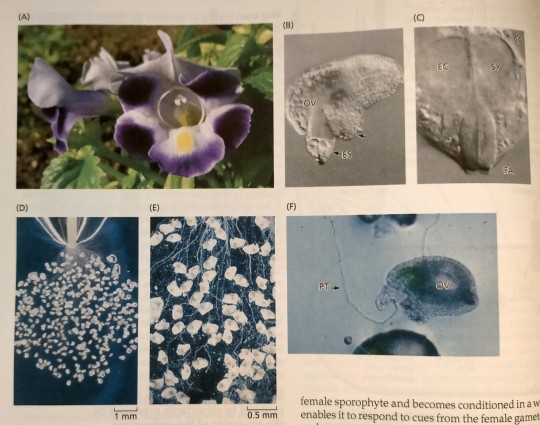
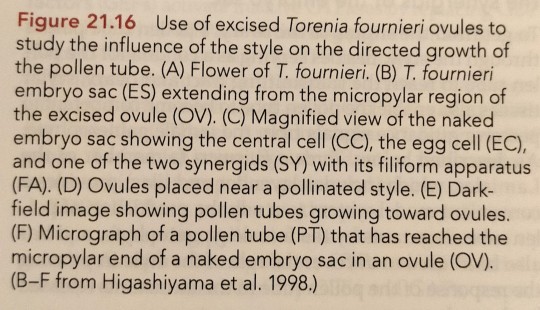
"Plant Physiology and Development" int'l 6e - Taiz, L., Zeiger, E., Møller, I.M., Murphy, A.
#book quotes#plant physiology and development#nonfiction#textbook#torenia fournieri#embryo sac#micropyle#funiculus#pollen#stigma#style#microscopy
0 notes
Text
Dicotyledonous Exalbuminous Seeds banks
Dicotyledonous Exalbuminous Seeds banks are a vital component of the global food supply. They are a storehouse of genetic diversity, allowing us to maintain crop yields and quality in the face of environmental change. These seed banks provide farmers with access to new varieties, giving them more options for meeting the changing needs of their local environment. By conserving and sharing the genetic diversity of dicotyledonous exalbuminous seeds, we can ensure that our food supplies remain resilient to environmental changes in the future.

Dicotyledonous Exalbuminous Seeds:
The common pea (Pisum sativum) is a good example of this type. When a mature green pod is carefully opened along the dorsal suture, placental tissue is seen spreading along the ventral suture, and the roundish seeds are seen arranged in two rows along the length of the pod.
A stalk called the funicle connects each seed to the placental tissue on the fruit suture. The placental end of the funicle is narrow, but it widens into a disc where it joins the seed. When the mature seed is detached, the funicle's broad end leaves a scar on the seed known as the hilum. The micropyle is a pinhole opening on the seed coat located next to the hilum.
Water is seen to ooze out of this micropyle when the seed is soaked, wiped, and squeezed. The
seed is protected by a light-colored tough seed coat. The test is the tough seed coat.
The tegmen, which is delicate and completely adherent to the inner side of the teste, is undetectable in the mature seed. When the seed coat is opened, the kernel is extracted. The embryo is found in dicotyledonous exalbuminous seeds. The two fleshy cotyledons stand out. These are fleshy because all of the nutrients required by the growing seedling in the first few days are stored here.
The two cotyledons are hinged to an axis (tigellum) and open out like a book. The tigellum is the future plant's axis. One end of the tigellum is pointed and protrudes from the cotyledons.
The radicle, also known as the rudimentary root, is located next to the micropyle. The protruding radicle is visible even when the seedcoat is not removed because it is hidden beneath the pouch-like expansion of the seedcoat.
The feathery plumule end of the tigellum is the first apical bud of the future plant and develops into the shoot. The plumule is found inside the cotyledons in a groove. The cotyledons attach to the tigellum at the first node on the axis, and careful examination reveals the presence of the first lateral buds in the cotyledon axils.
The brown seedcoat is the testa, but a papery white membranous layer on its inner side is the tegmen. Except for the shape, the embryo is identical to that of a pea.
Dolichos lablab is a type of bean seed that is widely available. As with peas, the seeds are found in the pod. They are larger and oval in shape. The seed coat is very hard and black, brown, or red in color (mostly testa with a thin fused tegmen). The funicle extends into a long raphe visible above the hilum. The embryo is normal.
There are several other dicotyledonous exalbuminous seeds that we frequently encounter. The seed of the tamarind (Tamarindus indica) is rectangular and covered by a hard shell-like seedcoat.
The hard covering on the mango seed (Mangifera indica) is actually the fruit's innermost layer (endocarp), which is not a part of the seed. A papery seed coat covers the two very large cotyledons inside. The two cotyledons of jackfruit (Artocarpus heterophyllus) are irregular and unequal in size. The seedcoat reveals both the testa and the tegmen. The cotyledons contain latex as well as a lot of starch.
The seed is rather flat in cucurbits (gourd, cucumber, and other Cucurbitaceae plants). The testa is horny and free of the inside thin tegmen. The cotyledons are also flat, despite the fact that they contain a lot of food matter, including oil.
Despite being white, they have vein markings. The sunflower seed (Helianthus annuus) is actually a fruit containing a single seed. The fruit wall or pericarp is the hard covering.
The oily embryo is found inside, surrounded by a brownish membranous seed coat. The cotyledons of mustard, groundnut (peanut), sesame, and flax (linseed) seeds are high in oil.
The seed of orange and lemon is sometimes poly-embryonic, meaning it contains more than one embryo. The oak acorn is a type of fruit. The edible part of the pomegranate (Punica granatum) is the testa.

Benefits of Dicotyledonous Exalbuminous seed bank:
1. Dicotyledonous Exalbuminous seed banks provide a secure and reliable source of crop varieties in the event of natural disasters or extreme weather conditions, which can cause losses in yield.
2. Such seed banks also offer an insurance policy against the loss of crop diversity due to rapid urbanization, industrialization, and agricultural practices.
3. The wide range of genetic diversity in Dicotyledonous Exalbuminous seed banks also increases the chances of finding new and improved traits to create better varieties of crops adapted to harsh environmental conditions.
4. These seed banks are essential for the conservation of rare and endangered species which may otherwise become extinct.
5. The use of Dicotyledonous Exalbuminous seed banks is highly beneficial for farmers as they can access a greater variety of seeds that can be used to grow their crops and increase productivity.
6. Seed banks also provide an important platform for research, as scientists and agriculturalists have the opportunity to study the genetic diversity of different crops in order to develop better and more efficient varieties.
7. With the help of Dicotyledonous Exalbuminous seed banks, farmers can also access seeds for traditional or heirloom varieties that may have been lost due to changing environmental conditions. This helps them maintain their cultural heritage as well as improve their yields.
8. Finally, seed banks provide a valuable service in terms of food security, as they are able to store seeds for future use and ensure that there is always a reliable source of food available.
Conclusion:
Dicotyledonous Exalbuminous Seeds are an important resource of biodiversity in the global agricultural landscape. They provide essential ecosystem services and help to maintain soil fertility. Furthermore, they can be used for energy production, stabilizing disturbed soils, and helping reduce climate change impacts by sequestering carbon. With the effects of climate change becoming more and more prominent, the need for resilient and sustainable seed banks is increasing. To effectively manage these resources and ensure they are used in a responsible manner, it is necessary to have an understanding of their diversity, ecology, reproduction, and dispersal strategies.
0 notes
Note
Hey, sorry if you don’t know this or if you’re a bad person to ask but a friend of mine showed me your blog and I thought I’d give it a shot. My parents gave me a lucky “stone” that was my grandpas but it looks a Lot more like a seed. It’s brown and kind of looks like a chestnut or conker seed but way skinnier and flatter. Again sorry if you don’t know or if this is a bother but if you have any idea of what it is I’d really appreciate it, have a lovely day!
you’d be surprised how often ‘is this a seed or a rock’ comes up in life in the seed lane, actually. the easiest way to do it would be just to take a good look at it; most seeds usually have a hilum, which is a little scar left from when it was attached to the fruit during development. i’d hesitate to call it a belly button despite the superficial similarities, especially because the actual mechanisms of how flower sex works and propagates life afterwards is hellish and just A Lot for everyone involved, but anyway the important part is that it retains a little mark from that grand adventure, and it’s usually visible. here’s a relatively conspicuous example of what i’m referring to:

and here’s one with the seed cut open to give a better idea of what’s going on:

(side note: the ‘micropyle’ thing noted the above diagrams is an even tinier hole where The Sex Happened, i.e, the opening where the tube transporting the sperm from the pollen on the flower went in while the seed was still an empty unfertilized ovule sac. truly, there’s just a whole lot going on with seeds.)
anyway, hilums can look different on different seeds, but if it’s chestnut-like it should be pretty conspicuous; if there’s no hilum, i’d say it’s relatively safe to assume it’s not a seed.
aside from that, the other really big (although waaaayyy less accessible to test) difference between seeds and rocks-that-kinda-look-like-seeds is that seeds breathe/respire (especially during germination), and rocks don’t. i bring this up because seeing this ask threw me back to an experiment we did in AP biology in high school that demonstrated this exact concept, and i think it’s pretty cool, even though the actual lab itself was kind of ill-fated in my class, lmao.
#'but wouldnt the seed have germinated by now???' you may ask#well. it would not surprise me if the seed was simply Vibing#knowing how long seeds can last in weird situations#(working to their benefit in seed banks nowadays)#if it is a seed at all#whether or not it would still be able to /grow/ after all those years is a whole different thing tho#asks#plont asks#seeds#thecreativemoron69
304 notes
·
View notes
Text

micropyle is a real word too it refers to like a plant thing. in caa when they talk about something called...something-phagy but it used actual latin roots to create a word that describes how the chimera ants reproduce offspring with features of the whatever they ate and it made sense to me based on what I'd learned in bio it was the coolest thing. the terminology adds to the realism
1 note
·
View note
Text
Plant Facts! Part 2
There are 3 main types of plant tissue:
Dermal tissue- the outer protective coating. This is usually made up of a single layer of epidermal cells. The cuticle then covers this tissue with cutin. Some leaves also have spikelike projections called trichomes. The epidermis typically does not have chloroplasts, however guard cells are a noteable exception to this rule.
Vascular tissue- this tissue transports water and nutrients. There are 2 kinds: xylem (made of tracheids and vessel elements) and phloem (made of sieve tube elements and companion cells) more on them later.
Ground tissue- This includes all tissue that is not encapsulated by dermal or vascular tissue. There are 3 major types: parenchyma, collenchema, and sclerenchyma cells.
Parenchyma cells resemble the traditional plant cell. They add support and are found as mesophyll cells, epidermal cells etc. Collenchyma cells do not have secondary cell walls. A noteable example are the strings on celery. Sclerenchyma cells have thick primary and secondary cell walls, with the addition of lignin. They exist purely for support.
Xylem
As mentioned before, xylem is made of tracheids and vessel elements. The secondary cell walls have the addition of lignin to provide support. Xylem makes up wood. Xylem carries nutrients and water up from the soil without energy. They do this via transpirational pull and cohesion tension. Cohesion is the tendency of a molecule to be attracted to itself.
The transpirational pull-cohesion tension theory says: For each molecule of water that evaporates from a leaf by transpiration, another molecule is drawn in by the root to replace it.
How weather impacts transpiration:
High humidity slows transpiration
High wind increases transpiration
Increased light intensity increases transpiration
(Not weather) Closed stomates stop transpiration
Phloem
As mentioned before, phloem is made of sleeve tube elements, and companion cells. It transports sugar from the leaves to the plant body via translocation. This process requires energy.
Plant Reproduction
Firstly, plants can reproduce asexually. They can clone themselves, or use a method called vegetative propogation. This is noted in grafting, cuttings, bulbs, and runners.
Flowers are the sexual organs of the plant. They are hemaphrodites, meaning they contain reproductive organs of both males and females.
My diagram is very messy. I���m very sorry. I’ll probably fix it at some point.

Pollination marks the beginning of reproduction. 1 pollen grain contains 3 haploid nuclei. 1 is a tube nucleus and 2 are sperm nuclei. The pollen grain attaches to the stigma. It germinates, creating a tube running down the style, into the ovary. The sperm will enter the ovule bia the micropyle. One sperm will fertilize the egg and become the embryo (2n). The other will fertilize the polar bodies, to become the triploid endosperm/cotelydon. (3n) This is the food for the embryo. This process is known as fertilization.
The ovule becomes the seed, and the ovary becomes the fruit. In monocots, the food remains in the endosperm? however in dicots, the food reserves are moved to cotelydons. The embryo is made of 3 parts; the hypocotyl, (the lower stem/roots), the epicotyl (the upper stem) and the radicle (embryonic root, the first to emerge from the seed)

The sexual lifespan of a plant is marked by the alternation of generations, meaning it alternates between the haploid generation and diploid generation.
The gametophytes (n) produce gametes that fuse during fertilization to become (2n) zygotes. Each zygote becomes a sporophyte through mitosis, which become haploid spores through meiosis. Via mitosis, each haploid spore becomes a gametophyte.
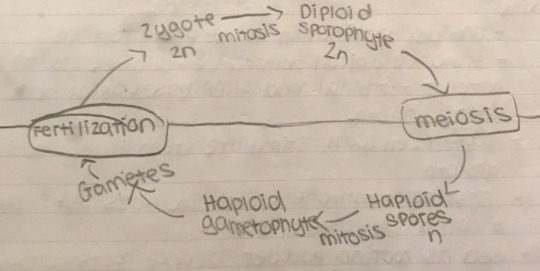
Here’s some vocab !
Antheridium- Structure that produces sperm, develops on the gametophyte
Archegonium- Structure that produces eggs, develops on the gametophyte
Gametophyte- Haploid adult plant
Megaspores- Made by female cones, become female gametophytes
Microspores- Made by male cones, become male gametophytes
Protonema- Branching, 1 cell thick filaments, made by germinating moss spores, become the moss gametophyte
Sporangia- Found on the tip of a mature sporophyte, where meiosis occure, creating haploid spores
Sporophyte- Diploid adult plant
Sori- Raised sports under sporophyte ferns, clusters of sporangia
In bryophytes like moss, the gametophyte is the dominant generation. The sporophyte receives its nutrients from the gametophyte generation, which gains its nutrients from photosynthesis.
In seedless, vascular plants, like ferns, the sporophyte generation is much larger than that of a bryophytes, and is independent. Both generations sustain themselves via photosynthesis
In advanced, vascular, seed plants, the sporphyte generation is much more dominant. In angiosperms, the gametophyte generation exists within the sporophyte generation and completely depends upon the gametophyte generation. In gymnosperms, the gametophyte generation comes from haploid spores within the sporangia.
Plant Hormones!
Hormones are responsible for coordinating growth, development, and response to stimuli. Some noteable hormones are:
Auxins
Phototropisms (a plants tendency to lean toward light) occur due to an unequal distribution of auxins
They enhance apical dominance (the tendency of a plant to grow vertically, not laterally). The terminal bud suppresses lateral growth by suppressing the growth of axial buds.
They stimulate stem elongation and growth by softening the cell wall
They were the first plant hormone found
Includes Indoleacetic acid (IAA) -naturally occuring and 24-D - man made weed killer
They are used as rooting powder as they help roots develop quickly.
A man made form of auxins are sprayed on tomato plants. This induces fruit production without fertilization, thus creating seedless tomatoes (yum)
Cytokinins
As the name suggests, cytokinins induce cytokinesis and cell division.
They delay senescence (a nerdy way to saying aging) as they inhibit protein breakdown.
Gibberellins
Gibberellins promote stem and leaf elongation.
They induce bolting, which is the rapid growth of a floral stalk. This is something commonly seen on plants like broccoli, where the plant will rapidly shoot out of the ground.
Abscisic Acid (ABA)
Along with sounding really freaking cool, abscisic acid halts growth, closes stomates and causes seed dormancy
This is useful during times of great stress such as during a drought.
Ethylene
Ethylene is a gas that induces ripening (and rotting). It also stimulates the production of ethylene in other plants. Basically, they make things great for everyone, but also spoil everything (mood)
Finally: tropisms. Tropisms are when plants move away from or towards a stimulus. Some examples are : thigmitropisms (touch), geotropisms/gravitropisms (gravity), and phototropisms (light)
So how do auxins cause phototropisms? Auxins build up in the shaded part of the plant. They induce growth, thus the plant grows and becomes heavy on the shady area. Thus the plant will bend.
Geotropisms are caused by the interaction between auxins and statoliths (specialized plastids containing dense starch grains)
#plant#plant biology#biology#SAT biology#SAT II#SAT subject tests#studyblr#biology studyblr#tropisms#plant hormones#plant reproduction#xylem#phloem
19 notes
·
View notes
Text
PULSES- STRUCTURE, COMPOSITION AND PROCESSING
WHAT ARE PULSES?
Pulses are basically a fruit part of leguminous crops that are harvested solely for the seeds. Dried beans, lentils, and peas are the most common known and consumed pulses. Pulses do not include crops which are harvested green – these are the vegetable crops. Also excluded are those crops used mainly for oil extraction and leguminous crops that are exclusively used for sowing…
View On WordPress
#composition#cotyledons#cuticle#decortication#embryo#fermentation#germination#hilum#hull#legume#micropyle#milling#processing#pulses#raphe#seedcoat#soaking#structure#testa#food
0 notes